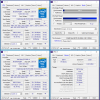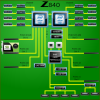- Mar 18, 2020
- 262
- 89
- 101
I like what I am seeing 

This thread will serve as a benchmark log for my ongoing HP z840 project. The rig is specifically built for benching and nothing else. Obviously, it cannot be overclocked, but still, I am thinking it will perform well against 12th gen processors / AMD processors as it stands. We will see about 13th gen, so the only thing I can do is come at it with as many cores as possible. This HP Z840 is now maxed out at the very limit of theoretical performance, with the highest spec'd core count CPUs (22C/44T each) and highest allowable memory speed (2400Mhz in octal channel [effective] configuration) and lowest possible memory latency (CL17).
The processors got lost in a shipment for years, so I was able to score them brand new and from a supplier in states for a pretty good deal.
I will be posting a number of benchmarks here as I test out these brand new CPUs and push them to the limit. Also comparing and contrasting to my old CPUs, two E5 2696 v3 processors, which had 18 cores and 36 threads.
Specs on new processors:
Note there is one error here, which is single core turbo speed. It's actually 3.7GHz not 3.6.

Rig we will be working with:




This thread will serve as a benchmark log for my ongoing HP z840 project. The rig is specifically built for benching and nothing else. Obviously, it cannot be overclocked, but still, I am thinking it will perform well against 12th gen processors / AMD processors as it stands. We will see about 13th gen, so the only thing I can do is come at it with as many cores as possible. This HP Z840 is now maxed out at the very limit of theoretical performance, with the highest spec'd core count CPUs (22C/44T each) and highest allowable memory speed (2400Mhz in octal channel [effective] configuration) and lowest possible memory latency (CL17).
The processors got lost in a shipment for years, so I was able to score them brand new and from a supplier in states for a pretty good deal.
I will be posting a number of benchmarks here as I test out these brand new CPUs and push them to the limit. Also comparing and contrasting to my old CPUs, two E5 2696 v3 processors, which had 18 cores and 36 threads.
Specs on new processors:
Note there is one error here, which is single core turbo speed. It's actually 3.7GHz not 3.6.

Rig we will be working with:



Last edited:












